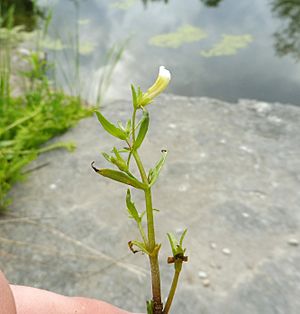Limestone hedge-hyssop facts for kids
Quick facts for kids Limestone hedge-hyssop |
|
|---|---|
 |
|
| Conservation status | |
| Scientific classification | |
| Genus: |
Gratiola
|
| Species: |
quartermaniae
|
Gratiola quartermaniae, also known as the limestone hedge-hyssop, is a type of flowering plant. It belongs to the plantain family. You can find it naturally in eastern North America.
Contents
What is Limestone Hedge-Hyssop?
Limestone hedge-hyssop is a small plant that loves wet, rocky places. It was first officially named in 2007. Before that, people often confused it with a similar plant called Gratiola neglecta.
Where Does Limestone Hedge-Hyssop Grow?
This plant grows in many different places, but its populations are spread out. You can find it most often in parts of Alabama and Tennessee. Other groups of these plants live far away in Texas, northern Illinois, Kentucky, and even southern Ontario in Canada.
No matter where it grows, this plant likes special habitats. It prefers flat areas of limestone rock where water often collects. These places are sometimes called cedar glades or alvars. Scientists think there might be more of these plants out there than we know right now.
Why is This Plant Important?
Because its populations are so scattered and it needs very specific places to grow, the limestone hedge-hyssop is considered vulnerable. This means it could be at risk. One big threat is habitat destruction, especially in middle Tennessee. This happens when the natural places where the plant lives are damaged or disappear.
How to Identify Limestone Hedge-Hyssop
Limestone hedge-hyssop looks a lot like its close relative, Gratiola neglecta. However, there are a few key differences. Its leaves are more linear, meaning they are long and narrow. The middle part of its stem is almost smooth, with very few hairs. Also, its seeds are thicker than those of its relatives.
What Do Its Flowers Look Like?
In the spring, the limestone hedge-hyssop produces pretty, cream-colored flowers. These flowers are shaped like small tubes.


